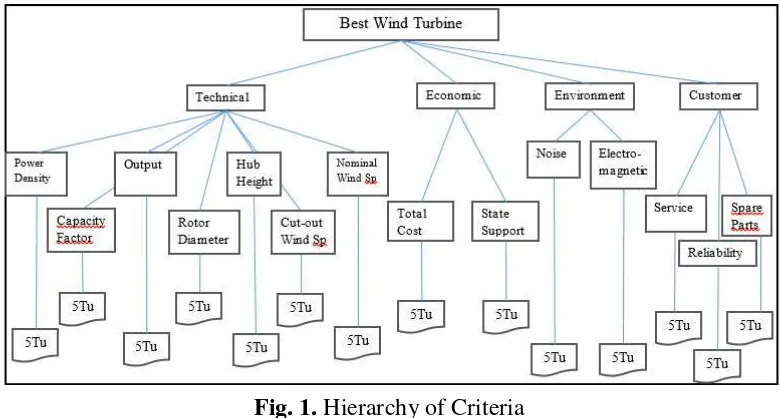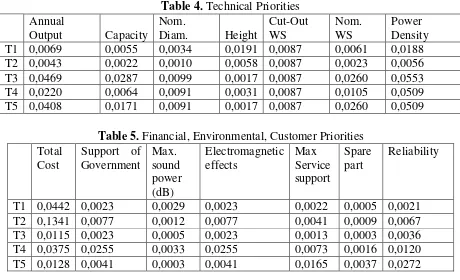COMPREHENSIVE DECISION-MAKING FOR EVALUATING
WIND TURBINES
Lutfu Sagbansua1 and Figen Balo2 1,2
Department of Industrial Engineering, Firat University, 23279 Elazig, Turkey E-mail: [email protected], [email protected]
Abstract: In this study, the AHP method was used to choose the best 7MW wind turbine for a wind farm design. Five diverse wind turbine brands were analyzed based on experts’ opinions on four groups of characteristics of these turbines. The data used is obtained from real companies.
Keywords: AHP, Wind turbine select, Renewable energy, Energy efficiency, comparison.
1. Introduction
The structure of wind power system contains three milestones. Firstly, wind power is
captured by turbine blades. Meanwhile the rotor changes it to rotational power conducted via
the drive turn to the generator. And then the produced electricity is fed to the grid or
contacted to the load. The primary parts of a wind turbine include a rotor that has airfoil
formed blades added to a center, an engine that exists a drive turn including the generator,
connecting shafts, a tower, a gearbox, a ground attached electrical device, support bearings,
and other mechanism [1]. For wind turbines, there are numerous diverse sizes and various
materials. For wind farm, the selection of the most proper wind turbine is very important
because the system’s capital cost is very high and wind turbines total up to 64% of total
expense. For this reason, the wind turbine should be selected by assessing all of the criteria to
fulfill the objective required such asless cost, having lower environmental impact, more
robustness, and more efficiency.
The various multi-criteria decision-making methods are widely performed in the wind energy
system in recent years. Chen et al. analyzed FAHP approach associated with the
opportunities, benefits, risks and costs concept to evaluate wind farm projects [2]. Minguez et
al. designed the suitable selection of the most appropriate support structures’ options for 5.5
MW wind turbine with TOPSIS [10]. Wu et al. applied AHP for location choosing problem
of wind farm using a wide diversity of criteria such as economics, risks, and accessibility [3].
Kolios et al. determined a methodology based on the TOPSIS for evaluation and
classification of diverse support structures for wind turbines [4]. Lee et al. used a
criteria decision making method, with the combination of AHP and the profits, opportunities,
costs, and risks notion for wind farm project [5].Chen et al. applied ANP to assess the wind
firm system [6].
In this paper, a wind turbine assessment system is composed, which includes technical,
economic, customer and environment criteria. And then, the comparative analysis of five
different wind turbine brands is made by using AHP. Among selected popular wind turbine
brands for 7MW, the best wind turbine selection is obtained by evaluating comprehensively.
1. Multi-Criteria Decision Making in Wind Turbine Selection
In an AHP hierarchy for choosing a wind turbine, the goal would be to choose the best
turbine. Technical, economic, environmental, and customer related factors are the four main
criteria that are used in majority of the related literature for making a decision. These criteria
are often subdivided into several sub-criteria. In this study, the technical criterion is
subdivided into output, capacity, rotor diameter, hub height, cut-out wind speed, and nominal
wind speed. The cost criterion is subdivided into total cost and state support. The
environmental criteria include noise and electromagnetic effects. Finally, the customer
satisfaction is measured using service, availability of spare parts, and reliability. Five
alternative 7 MW wind turbines are compared using AHP technique. The hierarchy
composed of these criteria is constructed as shown in the figure below:
Fig. 1. Hierarchy of Criteria
While measurements for some criteria are readily available, some others like customer
satisfaction can only be estimated with respect to other variables. As it is the case in all
multi-criteria decision making methods, the relative weights of such multi-criteria need to be determined.
criteria. Below are the resulting priorities of technical, economic, environmental, and
customer related factors. Upon calculations, the resulting priorities of technical, economic,
environmental, and customer related factors are as follows, respectively: 54%; 32%; 5%; 9%.
In the next step, there are groups of sub-criteria under each main criterion to be compared
two by two. In the technical subgroup, each pair of sub-criteria is compared regarding their
importance with respect to the technical criterion. Below are the resulting weights for the
criteria based on pairwise comparisons.
Table 1. Technical sub-group priorities Annual
At this point, the comparison for technical criterion has been made, and the AHP method has
derived the local priorities for this group. These priorities reflect on how much it contributes
to the priority of its parent, thus we need to calculate the global priority of each sub-criterion.
That will show us the priority of each sub-criterion with respect to the overall goal. The
global priorities throughout the hierarchy should add up to one. The global priorities of each
technical sub-criterion is calculated by multiplying their local priorities with the priority of
technical criterion which results in the following values:
In the economic subgroup, there is only one pair of sub-criteria, namely total cost of
investment and state support available. These elements are compared as to how important
they are with respect to the economic criterion. Environmental factors considered are noise
and electromagnetic effects. Comparison of these elements with respect to the environmental
consideration steads to the resulting weights. Finally, there are three sub-criteria in the
customer satisfaction subgroup, namely service, spare parts, and reliability. These elements
are compared as to how they add value towards the customer satisfaction.
Table 2. Global Priorities of Technical Sub-Group
Annual
Table 3. Global Priorities of Financial, Environmental and Customer Sub-Groups
Financial Environmental Customer
Opr. Cost St. Support Noise Elec.
Mgn.
Service Spare Reliability
3-Pairwise Comparisonof the Alternatives with Respect to the Criteria
After determining the priorities of each criterion with respect to the overall goal of selecting
the best wind turbine and priorities of sub-criteria with respect to their associated main
criteria, the turbine alternatives need to be compared two by two with respect to each
sub-criterion.
In order to measure the customer satisfaction towards the wind turbines, three sub-criteria is
defined: customer service, spare parts available, and the reliability of the company. Service is
evaluated to be positively related to the number of branches available for each company.
Spare parts are measured by the inventory levels of the companies while the reliability is
measured by their market shares and sales. The companies are ranked from 1 to 10 to be able
to generate a medium of comparison.
The next step in applying the AHP technique is two by two comparisons of the turbine
alternatives with respect to each sub-criteria. In order to design an objective scheme for this
purpose, the maximum and minimum values of the alternatives for each sub-criteria is
determined. This range is divided into nine even classes since AHP requires pairwise
comparisons on a scale from 1 to 9. Finally each alternative is placed in one of these classes
based on their values to compare them with eachother. Remainder of this section presents the
priorities obtained under each subcategory using this scheme.
Table 4. Technical Priorities
4. Conclusion
This study aims to find the most effective 7 MW wind turbine brand based on various criteria
exist in the literature. A list of criteria is evaluated and divided into four groups. Each
criterion is appointed a relative weight as a result of expert evaluations. Finally, AHP method
is applied to the resulting scheme. Based on the calculations above, the relative priorities
corresponding to the attractiveness of each wind turbine about all factors of technical,
financial, environmental and customer satisfaction are presented below:
Table 6. Wind turbine comparison
Technical Economic Environment Customer Total
T1 0,0684 0,0464 0,0052 0,0048 0,1248
T2 0,0300 0,1418 0,0089 0,0116 0,1923
T3 0,1771 0,0137 0,0027 0,0052 0,1987
T4 0,1107 0,0631 0,0288 0,0210 0,2235
T5 0,1543 0,0168 0,0044 0,0473 0,2229
The obtained results indicate that T4 and T5 are the two models with the highest priorities,
T4having slightly higher global priority of 0.2235and it is the alternative that contributes the
most to the goal of choosing the best wind turbine that satisfies all the criteria selected.T3 is
also the most efficient turbine in terms of technical properties, while T2 is the most
economical alternative. T4 is ranked higher than the others with a significant difference in
terms of environmental characteristics while T5 has the highest customer ranking.
References
[1] D. Ancona, J. McVeigh, Wind turbine-materials and manufacturing fact sheet, Princeton
Energy Resources International, LLC, 2001.
[2] HH. Chen, HY. Kang, A. Lee. Strategic selection of suitable projects for hybrid
solar-wind power generation systems. Renew Sustain Energy Rev 2010; 14:413–41.
[3] Y. Wu, S. Geng. Multi-criteria decision making on selection of solar, wind hybrid power
station location: a case of China. Energy Convers Manag. 2014; 81:527-533.
[4] K. A, M. Collu, A. Chahardehi, FP. Brennan, MH. Patel. A multi-criteria decision making
method to compare support structures for offshore wind turbines. In: European Wind Energy
Conference, Warsaw, 2010.
[5] L. AHI, C. Hung, HY. Kang. Multi-criteria decision making on strategic selection of wind
farms. Renew Energy 2009;34(1):120–6.
[6] HH. Chen, H-Y, Kang, AH. Lee. Strategic selection of suitable projects for hybrid


